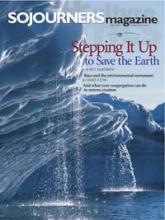In the evening of April 14, even as a jazz trio started playing for the first guests to arrive, the seven of us original organizers of the National Day of Climate Action were hunched over laptops—pretty much where we'd been for the last three months.
Except that this time, instead of typing press releases and permit applications, we were simply watching—with giddy and slightly unbelieving joy—as pictures started flowing in from around the country. These were photos of one of the biggest grassroots environmental protests in many years, the first big nationwide rallies designed to make Congress actually do something about global warming. In a few minutes we'd be showing them to our guests, important players in the Washington political scene. But for the moment we were simply soaking in the beautiful sights of a country waking up to its greatest challenge.
In Jacksonville, Florida, hunters and anglers hoisted a boat 20 feet in the air to show where the sea level would be if Greenland someday slid into the ocean. From lower Manhattan came pictures of people in blue shirts crowding into the Battery, a "sea of people" designed to show where the tide line may someday fall. From the Sierra and Rockies came shots of skiers descending on the dwindling glaciers. There were even pictures from the coral reefs off the Florida Keys where divers organized one of America's first underwater demonstrations. The pictures came from tiny towns and big cities—all 50 states and almost all congressional districts, 1,400 demonstrations in all, organized by environmentalists but also evangelical congregations, student activists, and sorority chapters.
Read the Full Article

